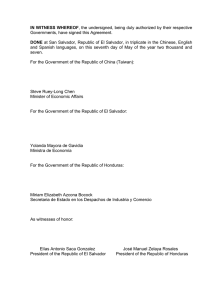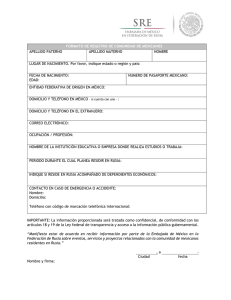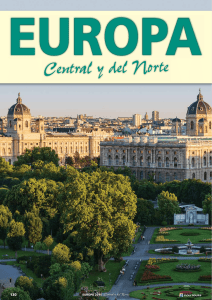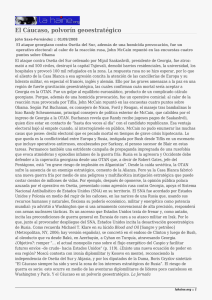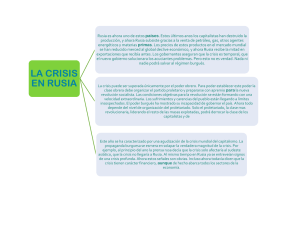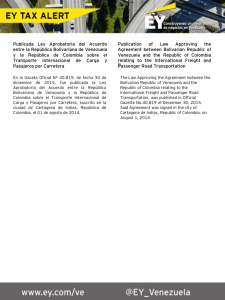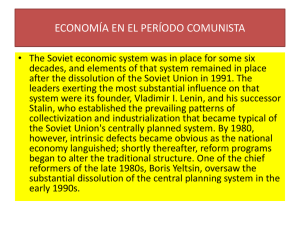magazine of the peoples - El instituto europa de los pueblos
Anuncio
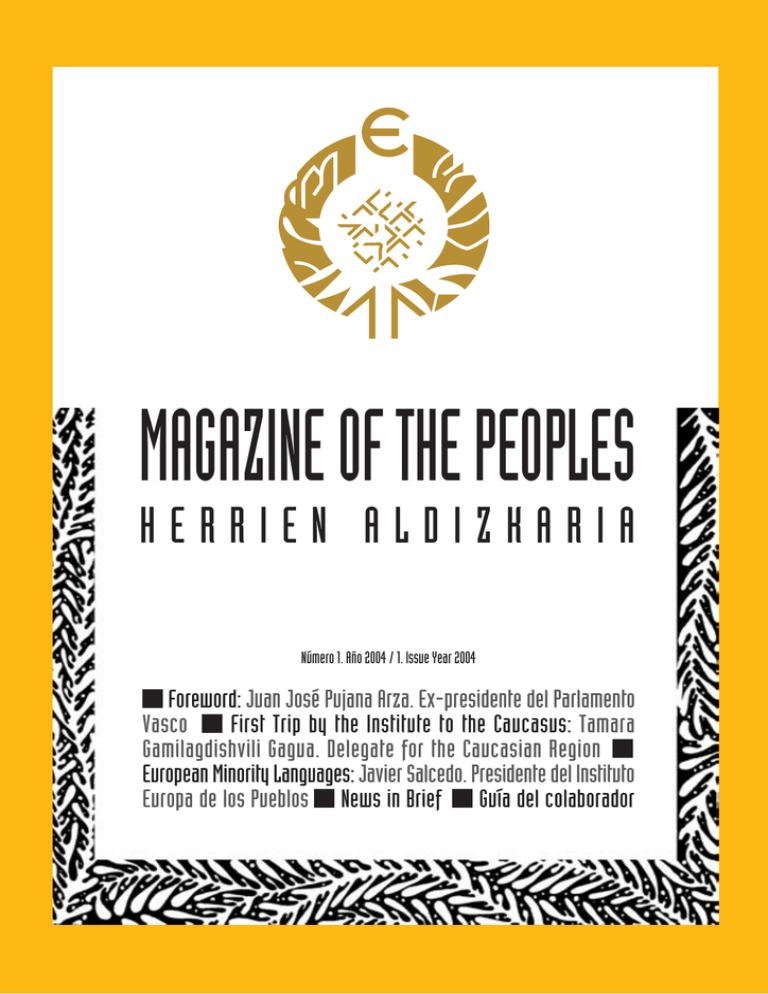
MAGAZINE OF THE PEOPLES HERRIEN ALDIZKARIA Número 1. Año 2004 / 1. Issue Year 2004 Foreword: Juan José Pujana Arza. Ex-presidente del Parlamento Vasco First Trip by the Institute to the Caucasus: Tamara Gamilagdishvili Gagua. Delegate for the Caucasian Region European Minority Languages: Javier Salcedo. Presidente del Instituto Europa de los Pueblos News in Brief Guía del colaborador SALUTACIÓN FOREWORD El Instituto Europa de los Pueblos, Fundación Vasca, Herrien Europa Institutua, Euskal Fundazioa, en cumplimiento de sus objetivos fundacionales, pone en marcha el presente instrumento de comunicación al servicio de todos los Pueblos que configuran la Europa real, desde las islas Canarias hasta los Urales. In fulfilment of one of its founding purposes, Instituto Europa de los Pueblos, Fundación Vasca/ Herrien Europa Institutoa, Euskal Fundazioa [“The Institute of the Europe of the Peoples, Basque Foundation”] introduces this publication in the service of all the peoples of Europe, from the Canary Isles to the Urals. La intención que informa o inspira todas las actividades de la Fundación no es otra que la de recopilar el conocimiento real de los Pueblos europeos y de sus culturas respectivas, así como la difusión de este conocimiento mediante diversos instrumentos. Esto supone el respeto y el reconocimiento de todos los Pueblos sin excepción, como fórmula de acercamiento, de conocimiento y comprensión mutua, como elemento fundamental para el asentamiento sólido de la paz, expresión del cumplimiento de los Derechos Fundamentales de la persona, tanto en su vertiente individual, como colectiva. Se pretende que el hombre, la persona siga siendo, como lo definió Protágoras, la medida de todas las cosas, de las que son en cuanto son y de las que no son en cuanto no son. The Foundation seeks to compile real knowledge of European peoples and their cultures, and to disseminate that knowledge in various ways. All peoples without exception are worthy of recognition and respect in pursuit of mutual learning and understanding. This in turn can form a solid foundation for peace in fulfilment of the people’s fundamental individual and collective rights. The idea is that human beings should continue to be, as Protagoras defined them, “the measure of all things: of what is, that it is, of what is not, that it is not”. La publicación que hoy emprende su andadura está abierta a la participación de todos; es decir, todos los Pueblos de Europa tienen en ella su lugar y su voz, sin distinción alguna, sean grandes o pequeños. Se constituye, pues, en tribuna abierta de todos ellos a fin de crear mutuamente vínculos crecientes de toda índole. Los verdaderos artífices de esta publicación serán, por tanto, los propios Pueblos, quienes no solamente darán cuenta de su propia existencia, sino también de sus aspiraciones, inquietudes, problemas, de sus culturas y de las noticias que estimen más relevantes. The publication which first sees the light here is open to all: every one of the peoples of Europe, large or small, has a place and a voice in it. It is an open forum that seeks to create and strengthen links of all kinds. The real makers of this magazine will therefore be the peoples of Europe themselves, who can give an account here not just of their existence but of their aspirations, concerns, problems, cultures and the news stories they consider to be most important. Initially at least this will be a bi-monthly magazine. Apart from the editorial, its main sections will be descriptions of peoples, news received from them and general information of interest in Europe. There will also be a “Suggestions” section through which the En principio, la publicación, en cuanto a su periodicidad, será bimestral. Sus secciones más significativas serán, además de las editoriales correspondientes, las que se refieran a las descripciones de los Pueblos, a las noticias que se reciban de los mismos, a la información general europea de interés. También habrá un apartado de sugerencias, de forma que, paulatinamente, vaya perfeccionándose la publicación. Se utilizará básicamente la lengua inglesa, sin perjuicio del uso de otros idiomas, en cuyo caso los textos adoptarán la forma de "separata" que se adjuntará a la edición principal. Se distribuirá en todos los Pueblos que conforman Europa. publication can be improved over time. The main language will be English, though others may also be used, in which case texts will be published as separata attached to the main issue. It will be distributed among all the peoples of Europe. Nowadays biodiversity is widely and rightly seen as a fundamental element in maintaining the balance of our ever-smaller world, and it must be proclaimed more firmly than ever that the first step in guaranteeing biodiversity needs to be taken at the level of individual persons in their natural and social environments. If the threat of extinction of an animal or plant species is cause for establishing all kinds of protective mechanisms, can we do less when it is a human community that is endangered? Hoy que se habla tanto y con razón de la biodiversidad como elemento fundamental para mantener el equilibrio en nuestro ya pequeño mundo, debe proclamarse más firmemente que nunca que esta biodiversidad debe comenzar a garantizarse a partir de la propia persona en todo su entorno natural y social. Si el peligro de extinción de una especie animal o vegetal hace que se pongan en marcha mecanismos de protección de toda índole, ¿qué es lo que no habrá que hacer cuando el peligro de extinción gravita sobre una comunidad humana? It is the peoples of Europe, many of them largely unknown and at times deliberately ignored, with the diversity of their cultures, their languages and their experiences, that make up the true Europe. They are its greatest treasure, and as such must be cared for and developed for the good of us all. We cannot and must not renounce our heritage. La diversidad de los Pueblos de Europa, tan desconocida y a veces ignorada a propósito, sus culturas, sus lenguas, en definitiva, sus experiencias constituyen la Europa real y su tesoro mas importante que es preciso cuidar y desarrollar en bien de todos. Constituye una herencia y un patrimonio a los que no podemos ni debemos renunciar. Juan José Pujana Arza Ex-presidente del Parlamento Vasco. “España 1936” Nestor Basterretxea. Basque leading sculptor. 1 EL PRIMER VIAJE DEL INSTITUTO EUROPA DE LOS PUEBLOS, FUNDACIÓN VASCA AL CÁUCASO FIRST TRIP BY THE INSTITUTE TO THE CAUCASUS Universidad de Nalchik (Ingushia). Nalchik University (Ingushia). D G eorgia is one of the key countries in the Caucasus. From the moment when we first made contact with the country various paths of co-operation, research and information opened up. The origin of the foundation’s representatives was probably also significant: both Vladimir Abzianidze and I are Georgians, and until recently we lived and worked in the Georgian capital Tbilisi. Indeed, one of the biggest agreements we signed was with the State University of Tblisi, where I studied in the 1980’s. esde los primeros contactos con las instituciones de uno de los Países clave de la región del Cáucaso, Georgia, se nos abrió varias vías diferentes de colaboración, investigación y fuentes de información. También habrá jugado un papel importante el origen de los representantes de nuestra fundación: tanto Vladimir Abzianidze, como vuestra servidora somos georgianos y hasta hace unos años vivíamos y trabajábamos en la capital georgiana, Tbilisi. De hecho uno de los contratos más importantes que hemos firmado fue con la Universidad Estatal de Tbilisi, donde estudié los años 80 del siglo pasado. Georgians have given much consideration to the idea of co-operating with the Institute, at academic, scientific and institutional levels. There have recently been many changes in the region as a whole and specifically in Georgia, and not just at the political and economic levels. France, Germany, the UK and especially the USA have expressed great interest and willingness to support the new Georgian government and its recently elected president. They will also clearly have to support academic and scientific circles, and indeed such support is now being shown through their embassies. Los georgianos, tanto al nivel académico y científico, como institucional han tomado con mucha consideración la idea de colaboración con el Instituto. Últimamente se producen muchos cambios en la región y concretamente en Georgia, y no me refiero sólo al nivel político o económico: los países como Francia, Alemania, Reino Unido y, sobre todo, Estados Unidos, ya han anunciado su gran interés y la disposición de apoyar al nuevo gobierno georgiano y su presidente recién elegido. Es evidente que tendrán que apoyar ya al mundo académico y científico, lo cual ya se está manifestando a través de las embajadas de los Países arriba citados. 2 ...hay tanta desinformación o ignorancia sobre la realidad de los Pueblos que habitan el Cáucaso... There is a great deal of ignorance and disinformation about the reality of the peoples of the Caucasus... El viaje fue bastante fructífero e interesante: tanto mis conocidos como otras personas que me recibían en diferentes instituciones, se mostraban muy abiertos y dispuestos a echar una mano: hay tanta desinformación o ignorancia sobre la realidad de los Pueblos que habitan el Cáucaso, una de las zonas más hermosas pero también conflictivas del mundo... The trip produced results, and proved to be most interesting: the people we met at the various institutions, some of whom I already knew and others whom I met for the first time, were extremely open and prepared to lend us a hand. There is a great deal of ignorance and disinformation about the reality of the peoples of the Caucasus, one of the world’s most beautiful areas but also one of the most conflict-ridden. Uno de los primeros contactos fue con la Biblioteca Nacional de Georgia, donde aparte de tener la información más amplia sobre los pueblos del Cáucaso, funciona el Centro de Estudios de Caucasiología. Tuve el gran honor de conocer y trabajar durante un mes con su director, uno de los caucasiólogos más importantes, Doctor Vladimir Kikilashvili. El dirige también varias ediciones científicas y la Cátedra de Caucasiología en el facultad de Signagui (Georgia Oriental) de la Universidad de Tbilisi. El catedrático Kikilashvili es uno de los mayores expertos en Daguestán, el país del Cáucaso del Norte más rico étnica y lingüísticamente. En el futuro esperamos colaborar con él y con la Cátedra de la Historia de los Pueblos del Cáucaso de la Universidad de Tbilisi (el catedrático Doctor Emil Kopaliani), ya que gracias a nuestros primeros contactos con ellos tenemos importantes planes de colaboración a largo plazo. One of our first contacts was with the National Library of Georgia, which not only contains the biggest stock of information on the peoples of the Caucasus but also houses the Centre for Studies in Caucasology. I had the great honour of meeting and working for a month with its director Dr. Vladimir Kikilashvili, one of the leading caucasologists of our times. He also manages numerous scientific publications and holds the Chair of Caucasology at the branch of the University of Tbilisi in Signagi (Western Georgia). Professor Kikilashvili is a leading expert on Dagestan, the richest country in the northern Caucasus in ethnic and linguistic terms. In the future we hope to work with him and with the Chair of History of the Peoples of the Caucasus at the University of Tbilisi (held by Dr. Emil Kopaliani): our initial contacts with them have resulted in major plans for long-term co-operation. Es imprescindible subrayar el interés y el apoyo que nos mostró la dirección del Instituto de Lingüística de Georgia. Un especial agradecimiento We must make special mention of the interest and support shown to us by the management of the Georgian Institute of Linguistics. Special Casco viejo de Tbilisi (Georgia) Old Tbilisi (Georgia. 3 a su Directora Sra. Gucha Kvaratsjelia y a los científicos, como Sr. Tsotsanidze, Sr.Shengelia, Sta.Ezugbaia, etc. Gracias a su desinteresada ayuda, en un tiempo récord pude elaborar un borrador de mi investigación sobre los Pueblos casi desconocidos del Cáucaso. El único problema que se nos presentó para terminar esta primera fase de acercamiento, fue el obstáculo burocrático que nos impedía hacer el viaje a Daguestán, ya que para los georgianos no existe casi nada que sea imposible, de este primer viaje no hemos vuelto con las manos vacías, ni mucho menos: conseguimos 11 contratos de colaboración con diferentes entidades estatales, académicas o privadas y pudimos asegurar el acercamiento con los pueblos del Norte del Cáucaso, tanto a través de Georgia, por ejemplo, con el centro de Caucasiología, como con la Academia de Ciencias de Rusia en Moscú (los países del Norte del Cáucaso siguen bajo el dominio de la Federación Rusa). El siguiente paso es acercarnos directamente a estos Pueblos y a sus representantes (por ejemplo, el Consejo de Ancianos, según los denominan en el Cáucaso), conocer sus opiniones e inquietudes, publicar sus historias y ofrecer al resto del mundo la parte hasta ahora oculta o poco conocida del planeta, situada en el cruce de dos mundos diferentes, Asia y Europa. thanks are due to its Director Ms. Gucha Kvaratsjelia and to the scientific staff, including Mr. Tsotsanidze, Mr. Shengelia and Ms. Ezugbaia among others. With their unselfish assistance I was able to draw up a draft for my research on the almost unknown peoples of the Caucasus in record time. The only hitch in this first approach phase was that bureaucratic problems prevented us from travelling to Dagestan. For Georgians almost nothing is impossible, and on this first trip we certainly did not come back empty-handed: we entered into 11 co-operation agreements with state-owned, autonomous and private organisations, and were able to assure closer links with the peoples of the northern Caucasus through Georgia, e.g. with the Centre for Caucasology and with the Russian Academy of Science in Moscow (the countries of the northern Caucasus remain under the domination of the Russian Federation). The next step is to make a direct approach to these peoples and their representatives (known in the Caucasus as the Council of Elders) to learn their opinions and their concerns, to publish their stories and to bring this hitherto hidden and relatively unknown region at the crossroads between Asia and Europe to the attention of the world. Por lo tanto, se ha decidido hacer otro esfuerzo y realizar un nuevo viaje al Cáucaso para terminar con la primera parte del proyecto de estudios de los pueblos que ocupan lugar en la lista de los pueblos desconocidos, los de sin estado, sin o con autonomía dentro de otro estado. Por ejemplo, los jundz, andi, lak, dido, dargil, lezgui, etc. que hablan sus propios idiomas y dialectos tanto de origen caucásico como del grupo turco, iraní, mongol o semito-camita. Repasemos brevemente estos grupos. It has therefore been decided to make the effort to organise another trip to the Caucasus to complete the first part of the project to study the peoples on the list of unknown peoples, those without a state and with or without a degree of autonomy within other states, e.g. the Hunzib, Andi, Lak, Dido, Dargin and Lezgin peoples, all of whom speak their own languages and dialects, some of Caucasian origin and others belonging to the Turkic, Iranian, Mongol and Semitic- Esta mezquita atiende a los miembros de la minoría musulmana de Vladikavkaz, capital de la República rusa de Alania (Osetia del Norte). This mosque serves members of the Muslim minority in Vladikavkaz, the capital of the Russian Republic of Alania (North Ossetia). 4 La familia de las lenguas autóctonas se denomina como Ibero-Caucasiana y se divide en 4 grupos: Hamitic families. Let us take a brief look at these groups. The autochthonous language family known as Ibero-Caucasian has four main groups: 1. El grupo de idiomas cartvelicas: cartuli (georgiano), svanuri (svan) y megruli (mengrel), 2. Abjasio-Adigue: adigeos, cabardinos, cherquesianos, abjasios (apsua), abazios; 3. Najos: chechenos (nojchi), ingushes (galga); 4. Daguestanis: avaros (maarulal), lakes (lak), dargules (dargan), thabasaranos (thabasaran), lezguinos (lezguar), agules (agul), rutules (ruthul), tsajures (tsajur), etc. 1. The Kartvelian languages: Georgian, Svan & Mingrelian 2. Abkhazian-Adyghian: Adygey, Kabardian, Cherkessian, Abkhaz, Abaza 3. Nakh: Chechen, Ingush 4. Dagestani: Avar, Lak, Dargwa, Tabasaran, Lezgian, Agul, Rutul, Tsakhur, etc. Apart from the Caucasian peoples, there are others that have lived in the Caucasus for centuries. They are divided into three basic ethnic and linguistic groups: Como, evidentemente, en esta región no sólo viven los caucasianos, sino otros muchos pueblos que hace siglos habitan el Cáucaso, también ellos se dividen en grupos étnicos y lingüísticos, concretamente, en 3 grupos diferentes: 1. Indo-European (Slavs, Armenians, Iranians and Greeks) 2. Altaic (Turks, Mongols) 3. Semitic-Hamitic (Assyrians, Jews) To detail and extend this research for the 1. La familia Indoeuropea (el grupo de eslavos, el de armenios, iraní y griego); 2. La familia Altaica (el grupo turco, el mongol); 3. La familia Semito-Camita (asirios y judíos). It would be a total failure to forget these peoples ... Sería un fracaso total y absoluto dejar en el olvido a estos Pueblos ... database of the Institute and for the future university chair that would be our greatest achievement, it is essential that the proposals and co-operation agreements reached be developed. We face the challenge of a Europe that is growing ever larger, with more and more open borders. It would be a total failure to forget these peoples who, although many have never heard of them, are among the oldest in the world, and who have managed to survive for millennia. Our first steps have been successful, and we wish to continue with hope and an enterprising spirit. We know where we are heading and what we want to achieve. The rest is just technical details that we believe we can organise with the help of the public institutions of the Basque Country and the countries of the Caucasus, and of the scientists and others who have supported us and will continue to support us. As mentioned above, our next step is to do something that has never before been achieved: to make a direct approach to these people and, trusting in the hospitality for which they are all renowned, seek to learn their feelings and concerns at first hand. As I say goodbye until the next issue of this new magazine, I would like to reiterate my thanks to them and to all those who are prepared to lend a hand. Para concretar y ampliar esta investigación para la base de datos del Instituto y la futura cátedra que sería el mayor logro de esta fundación, es imprescindible desarrollar las propuestas y contratos de colaboración que hemos conseguido. Estamos ante el reto de la Europa creciente y cada vez más amplia en sus fronteras abiertas. Sería un fracaso total y absoluto dejar en el olvido a estos Pueblos que para muchos ni siquiera existen, pero para otros son unos de los más antiguos del mundo que han sabido sobrevivir a milenios. Nuestros primeros pasos han tenido éxito y queremos seguir con la esperanza y espíritu emprendedor. Sabemos a dónde vamos y qué queremos conseguir. El resto es puro tecnicismo y creemos que podremos superar con la ayuda de las instituciones vascas y de los países del Cáucaso, gracias a los científıcos y las personas que nos han apoyado y seguirán apoyando. Por lo tanto, como ya hemos indicado, nuestro próximo objetivo es lo que hasta ahora nunca se ha hecho: acercarnos de forma directa a estos Pueblos y, confiando en la hospitalidad que caracteriza a todos ellos , intentar conocer de primera mano sus sentimientos e inquietudes. Con agradecimiento hacia a ellos y a cualquier persona que esté dispuesta a colaborar, me despido hasta nuestro próximo encuentro en esta nueva revista que cobrará vida gracias a vosotros. Tamara Gamilagdishvili Gagua. Delegate for the Caucasian Region. 5 LAS LENGUAS MINORITARIAS EUROPEAS EUROPEAN MINORITY LANGUAGES The number of living languages in the world, broken down continent by continent, is as follows: Las lenguas vivas en todo el mundo, cIasificadas por continentes, son: Asia África Oceanía América Europa Asia Africa Oceania America Europe 2.197 2.058 1.311 1.013 230 2,197 2,058 1,311 1,013 230 Fuente: Foreign Policy Source: Foreign Policy Nunca ha habido tantas lenguas en peligro de extinción. Las lenguas mueren a causa de la guerra, el genocidio, la enfermedad, la baja natalidad y por decisiones gubernamentales. Pero la globalización podría ser la mayor amenaza. A medida que el mundo se interconecta más, muchos de los que hablan l e n g u a s m i n o r i t a r i a s, especialmente los jóvenes, consideran su lengua materna una desventaja económica y social, y dejan de usarla. De las 6.809 lenguas vivas conocidas, se cree que más de 400 están en vías de extinción debido a que las utilizan pocos de sus hablantes, y a que la mayoría de ellos es de edad avanzada. There have never been so many languages in danger of extinction. Languages die out as a result of war, genocide, sickness, low birth-rates and government decisions, but globalisation could be the greatest threat yet. As the world becomes more and more interconnected, m a n y s p e a k e rs o f minority languages, especially the young, come to see their native languages as economically and socially disadvantageous, and cease to use them. Of the 6,809 living languages known, over 400 are believed to be on the way to extinction, with only a low number of mostly elderly speakers. Alrededor de 100 de estas lenguas están en peligro de desaparecer porque son utilizadas por menos de 1.000 hablantes, y se estima que para finales del siglo XXI habrán desaparecido unas 200 lenguas. Around 100 of those languages are in imminent danger of disappearing altogether, as they are spoken by less than 1000 people. It is estimated that 200 languages will have disappeared by the end of the 21st century. El Instituto ha realizado un trabajo recopilando las informaciones necesarias sobre las lenguas europeas que son utilizadas por menos de un millón de personas. The Institute has striven to compile information on those European languages that are spoken by less than a million people. The results of this work are summarised in the table below. En el cuadro siguiente aparecen los resultados de nuestro trabajo. LENGUAS / LANGUAGES HABLANTES / SPEAKERS LOCALIZACIÓN / LOCATION Indoeuropeas / Indo-European Eslavas / Slavic Montenegrino / Montenegrin Kachubo /Kashubian Sorbio / Sorb 380.500 150.000 70.000 República de Montenegro / Republic of Montenegro Provincia de Pomerania (Polonia) / Province of Pomerania (Poland) Región de Lusacia (Alemania) / Lusatia (Germany) 6 LENGUAS / LANGUAGES HABLANTES / SPEAKERS LOCALIZACIÓN / LOCATION Indoeuropeas / Indo-European Germánicas / Germanic Frisón / Friesian 353.000 Islandés / Icelandic Feroés / Faroese 269.000 46.600 Provincias de Frisia y Groningen (Países Bajos) / Provinces of Friesland and Groningen (Netherlands) Islandia / Iceland Islas Faroes (Dinamarca) / Faroe Islands (Denmark) Célticas / Celtic Galés / Welsh Bretón / Breton IrIandés / Irish Gaelic 528.000 289.000 196.000 Escocés / Scots Gaelic Manés / Manx 66.000 s/h / None Cornuallés /Cornish s/h / None Gales (Reino Unido) / Wales (UK) Región de Bretaña (Francia) / Brittany (France) Irlanda e Irlanda del Norte (Reino Unido) / Republic of Ireland and Northern Ireland (UK) Escocia (Reino Unido) / Scotland (UK) Se habló en la isla de Man (Reino Unido) hasta 1974 / Spoken on the Isle of Man (UK) until 1974 Se habló en el condado de Cornualles (R.U.) hasta 1777 / Spoken in the County of Cornwall (UK) until 1777 Románicas / Romance Valón / Walloon 700.000 Friulano / Friulian 550.000 Aromúnico /Aromanian 260.000 Corso / Corsican Romanche / Romanche Ladino / Ladin 156.100 40.000 35.000 Región Federada de Valonia (Bélgica) / Walloon Region (Belgium) Región de Friuli-Venecia Giulia (Italia) / Friuli-Venezia Giulia (Italy) Rumania, Albania, Grecia y Bulgaria / Rumania, Albania, Greece and Bulgaria Isla de Córcega (Francia) / Corsica (France) Cantón de los Grisones (Suiza) / Canton of Grishun (Switzerland) Provincias de Bolzano, Trento y Belluno (Italia) / Provinces of Bolzano, Trento and Belluno (Italy) Iranias / Iranian Oseto / Ossetian 467.000 Kurdo / Kurdish 289.000 Talish / Talish Tatí / Tati 242.000 22.000 República de Alania-Osetia (Rusia) y región autónoma de Samachablo-Osetia Meridional (Georgia) / Republic of AlaniaOssetia (Russia) and Autonomous Region of South OssetiaSamachablo (Georgia) Azerbaiyán, Armenia y Georgia / Azerbaijan, Armenia and Georgia Azerbaiyán, Armenia e Irán / Azerbaijan, Armenia and Iran Azerbaiyán, Armenia y República de Daguestán (Rusia) / Azerbaijan, Armenia and Republic of Dagestan (Russia) Vasco / Basque Vasco / Basque 755.000 Comunidad Autónoma Vasca, Comunidad Foral de Navarra (España) y departamento de los Pirineos Atlánticos (Francia) / Basque Autonomous Community, Community of Navarre (Spain) and Department of Pyrénées Atlantiques (France) 7 LENGUAS / LANGUAGES HABLANTES / SPEAKERS LOCALIZACIÓN / LOCATION Caucásicas / Caucasians Kartvelianas / Kartvelian Mingrelio / Mingrelian Svano / Svan Lazi / Lazi 360.000 40.000 2.000 Región de Samegrelo y República Autónoma de Abjasia (Georgia) / Samegrelo region and Autonomous Republic of Abkhazia (Georgia) Región de Svaneti (Georgia) / Svaneti region (Georgia) Repúblicas autónomas de Abjasia y Ajaria (Georgia) / Autonomous Republics of Abkhazia and Ajaria (Georgia) Adigue-abjasias / Adyghian-Abkhazian Kabardino / Kabardian 389.000 Adigué / Adygey Abjasio / Abkhaz 125.000 90.000 Cherkés / Cherkess 41.000 Abaza / Abaza 35.000 República de Kabardino-Balkaria (Rusia) / Kabardino-Balkaria Republic (Russia) República de Adigea (Rusia) / Adygey Republic (Russia) República Autónoma de Abjasia (Georgia) / Autonomous Republic of Abkhazia (Georgia) República de Karachay-Cherkesia (Rusia) / Republic of Karachay-Cherkessia (Russia) República de Karachay-Cherkesia (Rusia) / Republic of Karachay-Cherkessia (Russia) Najo-daguestanas Checheno / Chechen 859.000 Ávaro / Avar 551.000 Lezguino / Lezgian 433.000 Dargín / Dargwa 356.000 Ingush / Ingush Tabasaran / Tabasaran 215.000 101.000 Tsajur / Tsakhur 23.000 Rutul / Rutul 18.000 Agul / Agul 16.500 Andí / Andi 11.000 Bezhtín / Bezhta 9.000 Dido / Dido 8.000 Ajvaj / Akhvakh 6.000 Kryts / Kryts 6.000 Repúblicas de Chechenia y Daguestán (Rusia) / Republic of Chechnya and Dagestan (Russia) República de Daguestán (Rusia) / Republic of Dagestan (Russia) Repúblicas de Daguestán (Rusia) y Azerbaiyán / Republic of Dagestan (Russia) and Azerbaijan República de Daguestán (Rusia) / Republic of Dagestan (Russia) República de Ingushia (Rusia) / Republic of Ingushia (Russia) República de Daguestán (Rusia) / Republic of Dagestan (Russia) Repúblicas de Daguestán (Rusia) y Azerbaiyán / Republic of Dagestan (Russia) and Azerbaijan República de Daguestán (Rusia) / Republic of Dagestan (Russia) República de Daguestán (Rusia) / Republic of Dagestan (Russia) República de Daguestán (Rusia) / Republic of Dagestan (Russia) República de Daguestán (Rusia) / Republic of Dagestan (Russia) República de Daguestán (Rusia) y Georgia / Republic of Dagestan (Russia) and Georgia Repúblicas de Daguestán (Rusia) y Azerbaiyán / Republic of Dagestan (Russia) and Azerbaijan Azerbaiyán / Azerbaijan 8 LENGUAS / LANGUAGES HABLANTES / SPEAKERS LOCALIZACIÓN / LOCATION Caucásicas / Caucasians Najo-daguestanas Karata / Karata 5.000 Tindi / Tindi 5.000 Udi / Udi Bagvalal / Bagulal 5.000 4.000 Chamalal / Chamalal 4.000 Botlij / Botlikh 3.000 Godoberi / Godoberi 2.500 Hunzib / Hunzib 2.000 Jvarshi / Khvarshi 1.800 Jinalug / Khinalug Bats / Batz Buduj / Budukh Hinuj / Hinukh 1.700 1.600 1.000 1.000 Archi / Archi 900 República de Daguestán (Rusia) / Republic of Dagestan (Russia) República de Daguestán (Rusia) / Republic of Dagestan (Russia) Azerbaiyán y Georgia / Azerbaijan and Georgia República de Daguestán (Rusia) / Republic of Dagestan (Russia) República de Daguestán (Rusia) / Republic of Dagestan (Russia) República de Daguestán (Rusia) / Republic of Dagestan (Russia) República de Daguestán (Rusia) / Republic of Dagestan (Russia) República de Daguestán (Rusia) / Republic of Dagestan (Russia) República de Daguestán (Rusia) / Republic of Dagestan (Russia) Azerbaiyán / Azerbaijan Georgia / Georgia Azerbaiyán / Azerbaijan República de Daguestán (Rusia) / Republic of Dagestan (Russia) República de Daguestán (Rusia) / Republic of Dagestan (Russia) Urálicas / Uralians Finougrias / Finno-Ugric Marí / Mari 558.000 Udmurtia / Udmurt 508.000 Komí / Komi Carelio / Karelian 278.000 88.000 Sámi / Sami 34.000 Vepsio / Vepsi 13.000 Ingrio / Ingrian 1.300 Livonio / Livonian Vótico / Votic 300 50 Repúblicas de Mari-El, Bashkortostán, Tatarstán y Udmurtia (Rusia) / Republics of Mari-El, Bashkortostan, Tatarstan and Udmurtia (Russia) República de Udmurtia (Rusia) / Republic of Udmurtia (Russia) República Komi (Rusia) / Komi Republic (Russia) República de Carelia (Rusia) y Finlandia / Republic of Karelia (Russia) and Finland Noruega, Suecia, Rusia y Finlandia / Norway, Sweden, Russia and Finland República de Carelia y regiones de San Petersburgo y Vologda (Rusia) / Republic of Karelia and regions of St Petesburg and Vologda (Russia) Estonia y provincia de San Petersburgo (Rusia) / Estonia and province of St Petesburg (Russia) Letonia / Latvia Provincia de San Petersburgo (Rusia) / Province of St Petesburg (Russia) 9 LENGUAS / LANGUAGES HABLANTES / SPEAKERS LOCALIZACIÓN / LOCATION Urálicas / Uralians Samoyeda / Samoyed Néncico / Nenets 34.000 Distrito Autónomo de Yamalo-Nenets (Rusia) / Autonomous District of Yamalo-Nenets (Russia) Altaicas / Altaic Mongol / Mongol Kalmuko / Kalmyk 154.000 República de Kalmykia (Rusia) / Republic of Kalmykia (Russia) Kumiko / Kumyk 350.000 Gagauso / Gagauz 140.000 Karacháy / Karachay 135.000 Repúblicas de Daguestán, Chechenia y Osetia del Norte (Rusia), Kazajstán,Turkmenistán, Uzbekistán y Ucrania / Republics of Dagestan, Chechnya and Northern Ossetia (Russia), Kazakhstan, Turkmenistan, Uzbekistan and Ukraine República Autónoma de Gagauz-Yeri (Moldavia) / Autonomous Republic of Gagauz-Yeri (Moldova) República de Karachay-Cherkesia (Rusia) / Karachay-Cherkessia Republic (Russia) Repúblicas de Daguestán, Chechenia y Karachay-Cherkesia (Rusia), Turquía y Rumania / Republics of Dagestan, Chechnya and Karachay-Cherkessia (Russia), Turkey and Rumania República de Kabardino-Balkaria (Rusia) / Kabardino-Balkaria Republic (Russia) Turcas / Turkic Nogai / Nogay 90.000 Bálkaro / Balkar 76.000 Afroasiáticas / Afro-Asiatic Semítica / Semitic Maltés / Maltese 364.000 Malta / Malta Las fuentes utilizadas para elaborar este cuadro han sido las siguientes: The sources used to draw up this table were: Armazi-Iberiul kavkasiuri enatmtsniereba, Caucasian Knot: Encyclopedia, Ethnologue, Languages of the World, Geonative, Indigenous Minority Languages of Russia, Kafkas Vakfi - Caucasus Foundation, NUPI-Centre for Russian Studies, Organization for European Minorities, Promotora Española de Lingüística (ProeI), The Red Book of the PeopIes of the Russian Empire, UNESCO: Red Book of Endangered Languages, Wikipedia, The Free Encyclopedia, www.dagprauda.ru Hemos encontrado contradicciones en algunos idiomas sobre el número de hablantes correspondiente al año 2001, por lo que solicitamos a los lectores de la revista que detecten algún error que se pongan en contacto con el Instituto para informarnos y seguidamente entablaremos comunicación con él para analizar y corregir el error. Estamos convencidos de que con la colaboración de los lectores podremos disponer de los datos más ajustados posibles sobre las diferentes lenguas europeas de menos de un millón de hablantes. We have found contradictions in the data on the number of speakers for 2001 in some languages. Readers who detect errors in the magazine are asked to contact the Institute so that we can work with them to analyse and correct such errors. We are sure that with the help of our readers we can provide the most accurate data possible on European languages with less than one million speakers. INSTITUTO EUROPA DE LOS PUEBLOS FUNDACION VASCA Las Mercedes 5, bajo izda. 48930 Getxo Bizkaia (Spain) Tel. 34 94 464 81 76 e-mail: [email protected] Javier Salcedo Eguía Presidente del Instituto Europa de los Pueblos. 10 BREVES NEWS IN BRIEF SAMIS SAMIS El pasado 6 de febrero se celebró el día nacional Sami. La fiesta nacional es común para todos los sami que viven en Suecia, Noruega, Finlandia o Rusia. Esta fiesta se celebró por primera vez en 1993, al mismo tiempo que las Naciones Unidas declaraban el Año Internacional de los Pueblos Indígenas. February 6th saw the celebration of the national day of the Samis. This day is celebrated jointly by Samis living in Sweden, Norway, Finland and Russia. The day was first celebrated in 1993, when the UN declared the International Year of Indigenous Peoples. Localización del Pueblo Sami y bandera Sami. Sami People location and Sami Flag. Mujeres del Pueblo Sami. Women of Sami People. BÁLKAROS BALKARS En 1944 por orden de Stalin cerca de 38.000 bálkaros fueron expulsados de sus tierras en la república de Kabardino- Balkaria y llevados a Asia central. Dicen los historiadores que una de cada cuatro personas deportadas murió en los siguientes cuatro años. Los bálkaros pudieron regresar a su patria en1957. Around 38,000 Balkars were deported from their homeland in the Kabardino-Balkaria Republic to central Asia by order of Stalin in 1948. Historians recount that one in four of those deported died within the following four years. The Balkars were allowed to return to their homeland in 1957. Monte Elbrus, 5.642 m. el símbolo de la bandera. Mount Elbrus 5.642 m. the symbol of the flag. Bandera bálkara. Balkar flag. CHIPRIOTAS CYPRIOTS La comunidad greco-chipriota dio su voto negativo a la unificación de la isla el pasado 24 de abril. Hace ahora 30 años 180.000 personas de origen griego huyeron del norte de Chipre cuando el ejército turco invadió sus tierras. Los turco-chipriotas aceptan entregar el 8 % de las tierras bajo su autoridad. Los greco-chipriotas no lo aceptan y piden que 80.000 nuevos colonos turcos abandonen la isla. The Greek Cypriot community voted no to the unification of the island on 24th April. Around 30 years ago 180,000 Cypriots of Greek origin fled from the north of the island when it was invaded by Turkish forces. Turkish Cypriots offered to hand over 8 % of the land under their control. The Greek Cypriots refused to accept this and have called for 80,000 new Turkish settlers to leave the island. Mapa de Chipre. Cyprus map. Un greco-chipriota vota durante el referéndum. A Greek Cypriot voting during the referendum. 11 GRIEGOS GREEKS El fuego ha devastado el monasterio ortodoxo de Chilantari en el monte Áthos, norte de Grecia y más de la mitad ha quedado destruido. El monte Áthos constituye una comunidad religiosa autónoma bajo soberanía griega. Su población está compuesta exclusivamente por los monjes basilianos de 20 monasterios de religión ortodoxa. The Orthodox monastery of Chilantari on Mount Áthos in northern Greece has been devastated by fire, and over half of it has been destroyed. Mount Áthos is an autonomous religious community under Greek sovereignty, with a population made up entirely of Basilian monks. It comprises 20 Orthodox monasteries. Vista aérea del monasterio de Chilantari. Aerial view of the monastery of Chilantari. Chilantari durante el incendio. Chilantari during fire. KARELIOS KARELIANS En el marco del programa “Cultura de Rusia 20012005”, el maratón cultural internacional Kalevalskaya Mosaica, quiere atraer la atención del estado y de las instituciones públicas al desarrollo de las lenguas y culturas de los carelios, vepsios, y fineses. El programa pretende también crear las condiciones para la conservación de la identidad étnica, cultural y lingüística de los pueblos finoungrios de Carelia. An international cultural marathon under the name Kalevalskaya Mosaica, staged as part of the Russian Culture 2001-2005 programme, seeks to draw the attention of the state and of public institutions to the development of the languages and culture of the Karelians, Vepsi and Finns. It also seeks to create the conditions for conserving the ethnic, cultural and linguistic identity of the Finno-Ugric peoples of Karelia. Museo Etnográfico Vepsio en Sheltozero (Carelia). The Vepps Ethnographic Museum in Sheltozero (Karelia). Nurmoylitsy- uno de los pueblos carelios que mejor ha sido conservado. Nurmoylitsy - One of the Karelian villages that has been well preserved. DAGUESTÁN DAGESTAN En Daguestán la editorial "Júpiter" ha publicado en el año 2003 el libro sobre los ilustres daguestanís de los últimos tres siglos, entre ellos el famoso Shamil (siglo XIX), poeta Rasul Gamzatov (siglo XX) y Musa Manarov, uno de los famosos cosmonautas soviéticos de origen daguestaní. La autora del libro Maisarat Magamedova es escritora, poeta y dramaturga, muy famosa en su país, sobre todo por sus libros humorísticos. 2003 saw the publication in Dagestan by the Jupiter publishing company of a book on illustrious Dagestanis of the past three centuries, including the renowned Shamil (19th century), the poet Rasul Gamzatov (20th century) and Musa Manarov, a famous Soviet cosmonaut of Dagestani origin. The book’s author, Maisarat Magmedova, is renowned as a writer, poet and dramatist, and is best known for her humorous books. Shamil. Rasul Gamzatov. Musa Manarov. 12 PUEBLOS CAUCÁSICOS CAUCASIAN PEOPLES En la Universidad de Tbilisi (M. Dzavajishvili), por iniciativa de la Cátedra de la historia de los pueblos del Cáucaso se ha creado en el año 2004 el Centro educativo e investigación científica de los problemas del Cáucaso. En la formación del centro participaron científicos y caucasiólogos de diferentes países de la región, entre ellos georgianos, daguestanís, osetios, cherkesios, rusos etc. El proyecto pretende unir los esfuerzos de diversos especialistas en los problemas de diferentes géneros que atormentan actualmente esta región. 2004 has seen the creation at the initiative of the Chair of History of the Peoples of the Caucasus of the University of Tbilisi (M. Dzavajishvili) of a centre for education and scientific research into the problems of the Caucasus. The centre was formed with the participation of scientists and caucasologists from several countries in the region, including Georgians, Dagestanis, Ossetians, Cherkessians and Russians. The project seeks to bring together the efforts of various specialists in the different problems currently affecting the region. Universidad de Tbilisi. Tbilisi State University. Mapa de los grupos etnolingüísticos del Cáucaso de la Universidad de Texas. Etnoliguistic groups in Caucasian map of the Texas University. Guía del Colaborador 1.- Lea la revista y envíenos sus sugerencias, opiniones y colaboraciones para la difusión de los Pueblos de Europa. 2.- Solicitamos artículos con lenguaje claro, y que no sobrepasen las 500 palabras. 3.- Los protagonistas de los artículos son las diferentes comunidades culturales europeas y los temas fundamentales deben centrarse sobre: a) la historia, lengua, religión, folklore y gastronomía, así como los lugares de interés turístico en su País, b) la forma de "pensar", "sentir" y "actuar" de su pueblo en la actualidad. 4.- Para la ilustración de los artículos les agradeceríamos nos enviasen imágenes representativas de su región con diseños realizados por artistas locales o fotografías. Guide for Contributors 1. Read the magazine and send us your suggestions, opinions and contributions to help disseminate knowledge of the peoples of Europe. 2. Articles should be written clearly and should be no more than 500 words long. 3. Articles should centre on the various cultural communities of Europe, and specifically on (a) history, language, religion, folklore, gastronomy and tourist sites in each country; and (b) the current thoughts, feelings and actions of each people. 4. Articles may be accompanied by artwork produced by local artists or photographs representative of each area. Instituto Europa de los Pueblos - Fundación Vasca http://www.inst-europ.org
